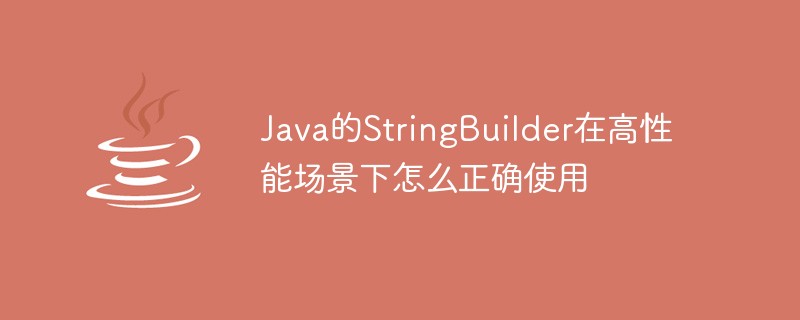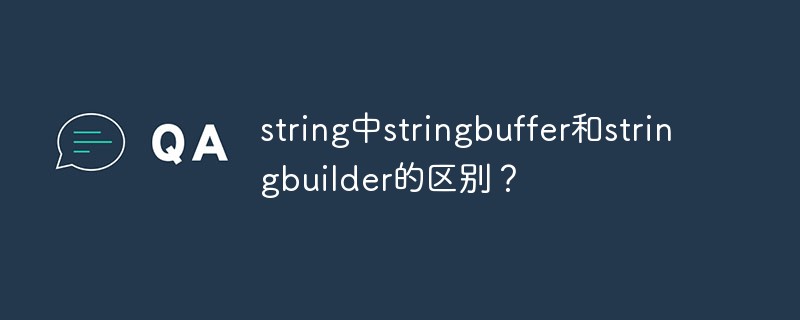Found a total of 35 related content

What are the methods to clear stringbuilder?
Article Introduction:The methods to clear stringbuilder are: 1. Use the setLength(0) method to clear the StringBuilder object; 2. Use the delete(0, length) method to clear the StringBuilder object; 3. Use the replace(0, length, "") method to clear the StringBuilder object; 4. , Use new StringBuilder() to re-create a new StringBuilder object.
2023-10-12comment 0983

The difference between string, stringbuffer and stringbuilder
Article Introduction:The differences between stringbuffer, stringbuilder, and string are: 1. The execution speed is different, and string is the slowest; 2. The thread safety is different, StringBuffer is thread-safe, and StringBuilder is thread-unsafe.
2020-06-19comment 02397

Convert string to StringBuilder in Java
Article Introduction:The append() method of StringBuilder class accepts a String value and adds it to the current object. Convert string value to StringBuilder object - Get string value. Append using the append() method to get the string into the StringBuilder. Example In the following Java program, we are converting an array of strings into a single StringBuilder object. Real-time demonstration publicclassStringToStringBuilder{ publicstaticvoidmain(Stringargs[]){&a
2023-09-02comment 0705

What is the difference between string, stringbuffer and stringbuilder?
Article Introduction:The difference between string, stringbuffer, and stringbuilder: 1. The content of the string class cannot be changed after it is declared, but the object content of the stringbuffer class can be changed; 2. The method of stringbuilder is not thread-safe.
2020-05-11comment 016669

How to use StringBuilder function in Java
Article Introduction:StringBuilder in Java is a class that allows you to modify strings without having to create new strings. Different from the String class, StringBuilder can add, delete, modify and query strings through append(), insert(), delete() and other methods, thereby changing the content of the original string. In many scenarios, using StringBuilder can significantly reduce memory overhead and program running time. This article will introduce how to use StringBuild
2023-06-26comment 0897

In Java, when should you use StringBuffer/StringBuilder instead of String?
Article Introduction:Objects of String class are immutable, while objects of StringBuffer and StringBuilder classes are mutable. StringBuffer is synchronous, while StringBuilder is asynchronous. The concatenation operator "+" is implemented internally using StringBuffer or StringBuilder. If the value of the object will not change, use the String class because String objects are immutable. If the object's value can change and can only be accessed from a single thread, use StringBuilder because StringBuilder is asynchronous. If the object's value can change and will be modified by multiple threads
2023-09-13comment 01006

Interpretation of Java documentation: Detailed introduction to the append() method of the StringBuilder class
Article Introduction:Interpretation of Java documentation: Detailed introduction to the append() method of the StringBuilder class. Java provides the StringBuilder class as a variable string type. This class provides a series of methods to operate strings. One of the most commonly used methods is append( )method. This article will introduce the append() method of the StringBuilder class in detail and attach specific code examples. StringBuilder class is in Java
2023-11-04comment 0986

How to use Java's StringBuilder correctly in high-performance scenarios
Article Introduction:The correct usage of StringBuilder in high-performance scenarios Regarding StringBuilder, most students simply remember that you should use StringBuilder for string splicing, do not use +, and do not use StringBuffer, and then the performance will be the best, is it true? ? Some students have also heard three specious experiences: 1. After Java is compiled and optimized, + has the same effect as StringBuilder; 2. StringBuilder is not thread-safe, and it is better to use StringBuffer for the sake of "security"; 3. Never do it yourself Concatenate the string of log information and leave it to slf4j. 1. The initial length is so important
2023-05-12comment 0430

How to use StringBuffer and StringBuilder in Java
Article Introduction:When modifying strings, you need to use the StringBuffer and StringBuilder classes. Unlike the String class, objects of the StringBuffer and StringBuilder classes can be modified multiple times without creating new unused objects. StringBuffer: When using the StringBuffer class, the StringBuffer object itself will be operated every time instead of generating a new object, so it is recommended to use StringBuffer if you need to modify the string. StringBuilder: The StringBuilder class was proposed in Java5, and it is similar to S
2023-06-02comment 01019

Java documentation interpretation: Detailed introduction to the length() method of the StringBuilder class
Article Introduction:Interpretation of Java documentation: A detailed introduction to the length() method of the StringBuilder class, specific code examples are required. Introduction: In Java programming, string processing is a very common operation. The StringBuilder class is a variable class provided by Java for operating strings. It provides a series of convenient methods to perform operations such as string splicing, insertion, and deletion. Among them, the length() method is an important method in the StringBuilder class and is used to
2023-11-03comment 0403

Interpretation of Java documentation: Detailed introduction to the substring() method of the StringBuilder class
Article Introduction:Interpretation of Java documentation: Detailed introduction to the substring() method of the StringBuilder class Introduction: In Java programming, string processing is one of the most common operations. Java provides a series of classes and methods for string processing, among which the StringBuilder class is a commonly used choice for frequent string operations. In the StringBuilder class, the substring() method is a very useful method for intercepting substrings of strings. This article will
2023-11-03comment 0366

Java documentation interpretation: Detailed introduction to the replace() method of the StringBuilder class
Article Introduction:Interpretation of Java documentation: A detailed introduction to the replace() method of the StringBuilder class. In Java, documentation is an important guide to understanding and using Java libraries. This article will introduce the replace() method of the StringBuilder class in Java in detail, including the method's function, parameters, return type, and detailed code examples. Method functions and descriptions The StringBuilder class is a class for variable string operations in Java. It provides a series of convenient methods to operate
2023-11-03comment 01038

Interpretation of Java documentation: Detailed introduction to the insert() method of the StringBuilder class
Article Introduction:Interpretation of Java documentation: Detailed introduction to the insert() method of the StringBuilder class. In Java, the StringBuilder class provides a series of methods for operating strings. Among them, the insert() method is a very useful method, which allows us to insert characters, strings, or other data type values at a specified position. This article will introduce in detail the use of the insert() method of the StringBuilder class and provide specific code examples. Str
2023-11-03comment 01014

Java documentation interpretation: Detailed introduction to the charAt() method of the StringBuilder class
Article Introduction:Interpretation of Java documentation: A detailed introduction to the charAt() method of the StringBuilder class. Specific code examples are required. Introduction: The StringBuilder class in Java is a variable string sequence that is used to handle the splicing and modification of strings. Java documentation provides detailed class and method descriptions to help developers better use these classes and methods. In this article, we will explain the charAt() method of the StringBuilder class in detail. StringB
2023-11-03comment 0732

Java uses the indexOf() function of the StringBuilder class to find the specified substring in the string
Article Introduction:Java uses the indexOf() function of the StringBuilder class to find a specified substring in a string. In Java programming, it is often necessary to perform various operations on strings, including finding specified substrings. In order to improve the search efficiency, we can use Java's StringBuilder class and the indexOf() function it provides to implement the function of finding substrings. First we need to understand what the StringBuilder class is. StringBuilder class is J
2023-07-27comment 01011

How to reverse a string using reverse() function of StringBuilder class in Java
Article Introduction:How to reverse a string in Java using the reverse() function of the StringBuilder class In Java, if we need to reverse a string, we can use the reverse() function of the StringBuilder class. The StringBuilder class is a mutable string object provided in Java, which can modify a string sequence without creating a new String object. The reverse() function can help us quickly reverse the string
2023-07-26comment 0630

Interpretation of Java documentation: Detailed introduction to the delete() method of the StringBuilder class
Article Introduction:Interpretation of Java documentation: A detailed introduction to the delete() method of the StringBuilder class, requiring specific code examples. Overview: In Java, the StringBuilder class provides an efficient way to operate strings. It has a series of methods to insert, append, replace and delete characters in a string. This article will introduce in detail the delete() method of the StringBuilder class, which is used to delete a specified range of characters from a string. This article will use specific codes to
2023-11-03comment 0774

Interpretation of Java documentation: Detailed introduction to the reverse() method of the StringBuilder class
Article Introduction:Interpretation of Java documentation: A detailed introduction to the reverse() method of the StringBuilder class. Specific code examples are required. Introduction: In Java programming, strings are a common data type. To operate and process strings, Java provides many built-in classes and methods. Among them, the StringBuilder class is a very useful class that allows us to dynamically modify and transform strings. In this article, we will delve into the re
2023-11-04comment 01056

How to use the append() method of the StringBuilder class to splice strings in Java
Article Introduction:How to use the append() method of the StringBuilder class to splice strings in Java. Splicing strings is a common operation in Java. During the splicing process, if the basic String class is used for string addition, new String objects will be created frequently, thus affecting performance. In order to solve this problem, Java provides the StringBuilder class to perform string splicing operations. StringBuilder class is one of the Java
2023-07-25comment 0934










